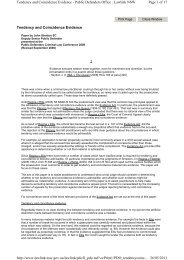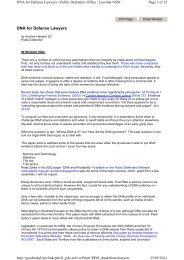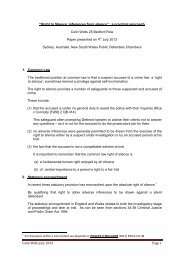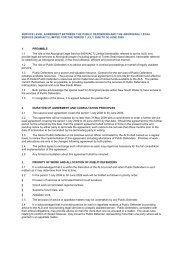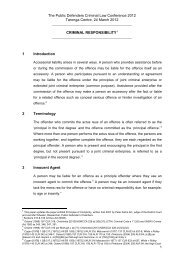Expert Evidence, by Dina Yehia SC - The Public Defenders
Expert Evidence, by Dina Yehia SC - The Public Defenders
Expert Evidence, by Dina Yehia SC - The Public Defenders
You also want an ePaper? Increase the reach of your titles
YUMPU automatically turns print PDFs into web optimized ePapers that Google loves.
[336] <strong>The</strong> trial judge's finding that the evidence of similarity between the wounds was<br />
relevant in this way obscured what we regard as a critical question, essential to resolve if<br />
the evidence was to meet the dual criteria for admission as opinion evidence under s 79.<br />
Neither counsel nor the trial judge grappled with this question on the voir dire. As we see it,<br />
that question is whether what Dr Culliford and Dr Cala identified as features of similarity in<br />
some of the wounds inflicted on the deceased were capable of supporting their further<br />
opinion (implicit at the time of the voir dire and explicit at the trial) that the injuries<br />
constituted a pattern of some discernible kind. <strong>The</strong> related question is whether that opinion<br />
was based wholly or substantially upon their specialised knowledge such as might<br />
rationally affect proof of the assessment <strong>by</strong> the jury of whether there was one stabber or<br />
two.<br />
…<br />
[340] In the course of the voir dire the trial judge accepted that there was no organised<br />
body of knowledge deriving from recognised principles of medical science which would<br />
enable either Dr Cala or Dr Culliford to express an opinion as to whether the wounds<br />
sustained <strong>by</strong> the deceased in this case were inflicted <strong>by</strong> one killer or more. He apparently<br />
accepted Professor Cordner's evidence on that issue. That being the case, the criteria for<br />
admission of what remained of the evidence translated into a requirement that Dr Cala or<br />
Dr Culliford be shown to have specialised knowledge in the interpretation of stab wounds<br />
based upon their training, study or experience as forensic practitioners, and that their<br />
opinion that there were discernible similarities in the wounds, manifesting as a discernible<br />
and distinct pattern in the wounds sustained <strong>by</strong> the deceased, was based wholly or<br />
substantially upon that knowledge.<br />
…<br />
[346] Even were the evidence admissible under s 79, we are nevertheless satisfied that it<br />
ought to have been rejected in the exercise of discretion under s 137 of the <strong>Evidence</strong> Act.<br />
Properly analysed, the evidence of the Crown experts that the wounds "appeared similar"<br />
was of little probative value, while the risk that the jury would impermissibly use the<br />
collective force of the evidence from the three Crown witnesses to infer that the similarity<br />
created a pattern, which was explicable only if the applicant was the perpetrator, was<br />
overwhelming. This was a risk that the trial judge's directions could not protect against.<br />
…<br />
[349] We are also satisfied that the Crown Prosecutor's repeated use of various adjectives<br />
to describe the similarity in the wounds, which was a submission unsupported <strong>by</strong> an<br />
application for admission of the evidence under s 98 of the <strong>Evidence</strong> Act, exceeded the<br />
legitimate bounds of a closing argument <strong>by</strong> a Crown Prosecutor. Her approach is the more<br />
egregious where the trial judge had not admitted the evidence under s 98 of the <strong>Evidence</strong><br />
Act and had expressly prevented the expert witnesses from using these very words, or<br />
words like them, when describing the extent of similarity in the pattern of injury about which<br />
they were permitted to give evidence.<br />
(iii)<br />
Dr Lawrence on the level of carbon monoxide:<br />
Dr Lawrence performed the post-mortem examinations in 1993. By the time of the trial he had conducted<br />
between 3,000-4,000 post-mortem operations. In part, he gave evidence of carbon monoxide levels in the<br />
bodies of the deceased. Importantly, he gave evidence that the carbon monoxide level in the body of<br />
Christopher Gilham was 6% which he opined was within the normal range. He concluded that Christopher<br />
Gilham was dead when the fire started. This evidence was highly significant in light of the defence case that<br />
Christopher was the murderer.<br />
[597] From the evidence led at trial it was generally accepted that:<br />
16



